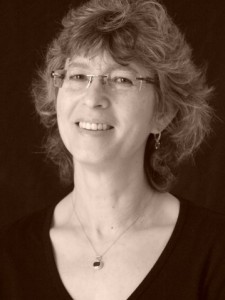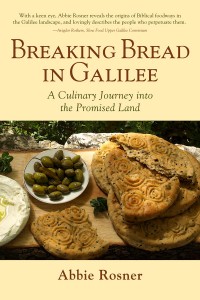Writing in the Culinary Landscape of the Galilee
Twenty-six years ago, I left the US to live on a farm in the Galilee.
It wasn’t a spiritual connection to the Holy Land that prompted this dramatic relocation, but a chance meeting with a handsome young Israeli farmer.
In an act that was equal parts folly and fortune, I followed him back, married him, bore two children, and set about making this foreign country my home.
After spending my entire life in cities, I came to love country living, and the long walks my husband and I took through the fields and forests surrounding our home eased my homesickness. Learning Hebrew was slow, and for years I was practically mute outside of the baby talk that filled my days.
Once the grip of my children’s demands began to ease and I could lift my head and re-connect to my inner core, I understood that I am a writer. Since then, discovering my writer’s voice has been the defining adventure of my life.
At first I wrote copy, comfortable in the anonymity of marketing jargon. But there was little satisfaction in working as a hired pen, and I yearned to write something that was my own. On a walk in the fields one day, I met an older Bedouin man from one of the nearby villages, gathering the wild spinach that sprouts along the sides of fields during the rainy winter season. I had always been intrigued by the local practice of this most ancient of foodways, and this chance encounter struck me with inspiration. My first article, A Time to Gather – Foraging for Edible Wild Plants with Bedouins of the Galilee, was published in Gastronomica magazine, and I knew that I had found my niche. Like a climber facing Everest, I decided to write a book about the local foods of the Galilee.
Over several years I had countless conversations with cooks, farmers, and bakers, in Jewish and Arab villages across the Galilee. I found the courage to negotiate maps and drive alone to distant destinations. In my accent-heavy Hebrew, I spoke to strangers about food, and watched their wariness and reticence magically melt into gracious hospitality. As the conversations developed, friendships grew and deepened. Discovering the power of food as a bridge for communication across the Jewish-Arab divide was transformational. I became a welcome guest in the homes of Arab families, sharing meals, joys and heartaches, and my life was immeasurably enriched.
Part of my research involved reading about the history of Mediterranean foods, and very quickly I found myself delving into the most venerable account of how life was lived here in ancient times. As a secular Jew, for the first time in my life, I read the Old Testament straight through, marking places where foods or foodways were mentioned. These descriptions, I found, resonated deeply with what I was discovering in my explorations of the rural villages of the Galilee.
I harvested green wheat with a sickle alongside local farmers, like Ruth the Moabite. I helped pick grapes alongside a farmer who planted his vineyard exactly as it is described in the Book of Isaiah. I tasted bread that was baked on stones heated on an open fire, and figs pressed into cakes, like those offered by Avigael to the young King David. Who could imagine that these ancient foodways were still being practiced today, many of which are on the verge of extinction? It took my outsider’s eye to see the big picture, and my writer’s sensibility to document it.
Ultimately, in yet another moment of truth, I realized that the story I was compelled to tell was not only about the foods of the Galilee, but about the exceptional people I met on my journey, and the love and trust I discovered through the simple act of breaking bread. The voice, and the story, would be in the first person – straight from the heart.
__
Abbie Rosner is the author of Breaking Bread in Galilee – a Culinary Journey into the Promised Land, available here. You can check out her blog, Galilee Seasonality, her tours site, Culinary Tours of the Galilee, and follow her on Facebook and LinkedIn.
Category: Contemporary Women Writers, Travel Writing by Women, Women Writers Across Cultures
Comments (5)
Trackback URL | Comments RSS Feed
Sites That Link to this Post
- Featuring Women Writers on WWWB 2013 - Women Writers, Women Books | December 31, 2013






I am enjoying your book, Breaking Bread in the Galilee. I spent time in the 60s at Gesher Haziv and so am familiar in a way with the area. Wondering why no photos of the area and the food. It would have added a lot to the book. Maybe cost too much??
Also, I noticed early in the book, and again on page 163, you refer to the Smithsonian Institute. It is of course the Smithsonian Institution. Usually the use of Institute shows someone not familiar with the areas but you are from Washington, DC…so the error should not have been made or caught by a copy editor…
Not even sure you’ll see this as the other comments are dated but had no other way to reach you. Hopefully if the book is published in a second edition, you can correct the error.
Thanks Julie for your comments. You are right about the lack of photos – it was in fact an economic decision. The plan for the next book is to include beautiful images.
An interesting observation about the Smithsonian – I did indeed grow up in DC and I suppose that it was our local custom to call it the Smithsonian Institute – a name that sounded suitably distinguished rolling off my tongue at a very young age. Funny where our blind spots originate…
Thanks again for taking the time to write.
Thanks Miriam – The Jewish and Arab worlds have been intertwined for centuries. There is so much to learn and share from each other, if we are open…
A lovely post Abbie and so interesting to hear how ordinary local people in Israel,from all background, inspired your interest in local food. My husband comes from the Iraqi Jewish community ( I am a London born Jew) and so for the last 35 years I have had the chance to learn an entirely new cuisine deeply influenced by interface between the Arab world and the Jewish world. Good luck with your book and your writing!